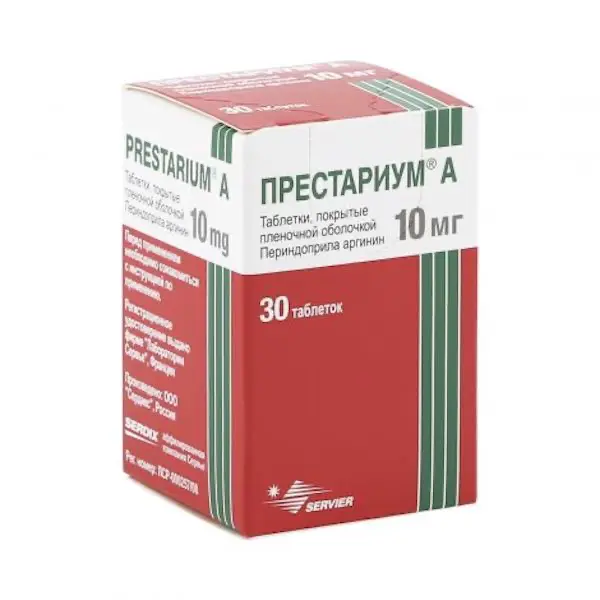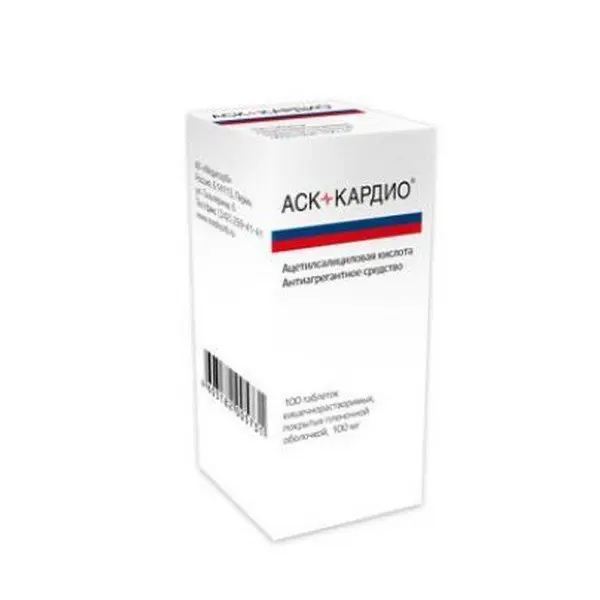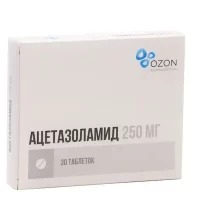Description
Prestarium A Pharmacodynamics
Mechanism of action
Perindopril is an inhibitor of the enzyme that converts angiotensin I to angiotensin II.
ACE, or kininase II, is an exopeptidase that both converts angiotensin I into the vasoconstrictor angiotensin II and degrades bradykinin, which has a vasodilator effect, into an inactive heptapeptide.
ACE inhibition leads to a decrease in the plasma concentration of angiotensin II, which causes an increase in plasma renin activity (by a “negative feedback” mechanism) and a decrease in aldosterone secretion.
Since angiotensin-converting enzyme inactivates bradykinin, ACE suppression is accompanied by an increase in both circulating and tissue kallikrein-kinin system activity, and the prostaglandin system is also activated. It is possible that this effect is part of the mechanism of antihypertensive action of ACE inhibitors, as well as the mechanism of development of some side effects of this class of drugs (e.g., cough).
Perindopril has a therapeutic effect due to the active metabolite perindoprilat. Other metabolites have no inhibitory effect against ACE in vitro.
Clinical efficacy and safety
Arterial hypertension
Perindopril is effective in therapy of arterial hypertension of any severity. Against the background of using the drug, both systolic and diastolic blood pressure (BP) in “lying” and “standing” position are decreased.
Perindopril reduces total peripheral vascular resistance (TPR), which leads to a decrease in BP, while peripheral blood flow is accelerated without changing heart rate (HR).
As a rule, perindopril leads to an increase in renal blood flow, glomerular filtration rate does not change.
Antihypertensive effect of the drug reaches a maximum of 4-6 hours after a single oral dose and lasts for 24 hours. In 24 hours after oral administration, marked (about 87 to 100%) residual ACE inhibition is observed.
Decrease in BP is achieved fairly quickly. In patients with a positive response to treatment, BP normalization occurs within a month and persists without the development of tachyphylaxis.
Discontinuation of treatment is not accompanied by the development of a “ricochet” effect.
Perindopril has a vasodilator effect, helps to restore elasticity of large arteries and vascular wall structure of small arteries, and also reduces left ventricular hypertrophy.
Concomitant administration of thiazide diuretics increases the severity of the antihypertensive effect. In addition, the combination of ACE inhibitor and thiazide diuretic also reduces the risk of hypokalemia with diuretics.
Heart failure
Perindopril normalizes heart function by reducing preload and postload.
Indications
-arterial hypertension;
-chronic heart failure;
-Prophylaxis of recurrent stroke (combined therapy with indapamide) in patients who have had a stroke or a transient cerebral circulation disorder of the ischemic type;
-stable CHD: reduction of risk of cardiovascular complications in patients with stable CHD.
Contraindications
-Hypersensitivity to the active substance, other ACE inhibitors and excipients (see section “Composition”) included in the preparation;
-history of angioedema (Quincke’s edema) associated with ACE inhibitor administration (see section “Special Precautions”);
-heritable/idiopathic angioedema;
-pregnancy (see sections “Special Precautions” and “Administration during Pregnancy and Breastfeeding”);
Breast-feeding (see section “Administration during pregnancy and breast-feeding”);
-concomitant use with aliskiren and medicinal products containing aliskiren in patients with diabetes mellitus and/or moderate or severe renal dysfunction (glomerular filtration rate (GFR) < 60 ml/min/1.73 m2 body surface area) (see sections “Interaction with other medicinal products” and “Pharmacodynamics”);
-concomitant use with angiotensin II receptor antagonists (APA II) in patients with diabetic nephropathy (see section “Cautions”);
-Combined use with combination medicines containing valsartan + sacubitril (see Sections “Special Precautions” and “Interaction with other medicinal products”);
-extracorporeal therapy leading to blood contact with negatively charged surfaces (see section “Interaction with other drugs”);
-Severe bilateral stenosis of the renal arteries or stenosis of the artery of the only functioning kidney (see also section “Special Indications”);
-lactase deficiency, lactose intolerance, glucose-galactose malabsorption syndrome;
-age under 18 years (effectiveness and safety have not been established).
Dosage and administration.
- Orally, 1 tablet once a day, preferably in the morning, before meals.
- At a choice of the dose it is necessary to consider features of a clinical situation (see section “Particular indications”) and degree of pressure decrease on a background of carried out therapy.
- Arterial hypertension
- Prestarium® A may be used both in monotherapy and in combination therapy (see sections “Contraindications”, “Particular indications” and “Pharmacodynamics”).
- The recommended starting dose is 5 mg once daily.
- In patients with significant activity of renin-angiotensin-aldosterone system (especially with renovascular hypertension, hypovolemia and/or decreased plasma electrolytes, decompensation of chronic heart failure or severe arterial hypertension) a marked BP decrease may develop after the first dose of the drug. At the beginning of therapy, such patients should be under close medical supervision. The recommended initial dose for such patients is 2.5 mg once daily.
- If necessary, a month after the start of therapy, the drug dose may be increased to 10 mg once daily.
- At the beginning of therapy with the drug Prestarium® A, symptomatic arterial hypotension may occur. In patients concomitantly receiving diuretics, the risk of arterial hypotension is higher due to possible hypovolemia and decreased plasma electrolytes. Caution should be exercised when using Prestarium® A in this group of patients.
- It is recommended to discontinue diuretics 2-3 days before the expected start of therapy with Prestarium® A, if possible (see section “Special Precautions”).
- If diuretics cannot be stopped, the initial dose of Prestarium® A should be 2.5 mg. At the same time, renal function and serum potassium content should be monitored. Later, if necessary, the drug dose may be increased. If necessary, the use of diuretics may be resumed.
- In elderly patients, treatment should be started with a dose of 2.5 mg per day. If necessary, after one month of therapy, the dose can be increased to 5 mg per day and then to 10 mg per day, taking into account renal function (see Table. 1).
- Heart failure
- The treatment of patients with chronic heart failure with Prestarium® A in combination with potassium-preserving diuretics and/or digoxin and/or beta-adrenoblockers is recommended to be started under close medical supervision with a starting dose of 2.5 mg once daily, in the morning. After two weeks of treatment, the dose may be increased to
- 5 mg once daily if the 2.5 mg dose is well tolerated and the response to therapy is satisfactory.
- In patients with severe heart failure as well as in high-risk patients (patients with impaired renal function and tendency to impaired water-electrolyte balance, patients simultaneously receiving diuretics and/or vasodilators), the treatment should be initiated under close medical supervision (see section “Special indications”).
- In patients at high risk of symptomatic arterial hypotension, such as those with reduced electrolytes with or without hyponatremia, with hypovolemia or with intensive diuretic therapy, before starting the drug
- Prestarium® A, these conditions should be corrected if possible. Parameters such as BP, renal function and plasma potassium should be monitored both before and during therapy.
- Prevention of recurrent stroke (combination therapy with indapamide)
- In patients with a history of cerebrovascular disease, therapy with Prestarium® A should be started with a dose of 2.5 mg for the first two weeks, then increasing the dose to 5 mg for the next two weeks until indapamide is used.
- Therapy should be started at any time (from two weeks to several years) after a stroke.
- CHD: reduction of risk of cardiovascular complications in patients with previous myocardial infarction and/or coronary revascularization
- In patients with stable CHD, therapy with Prestarium® A should be started with a dose of 5 mg once daily.
- After 2 weeks, in case of good tolerance and taking into account renal function status, the dose can be increased to 10 mg once daily.
- Elderly patients should start therapy with a dose of 2.5 mg once daily for one week and then 5 mg once daily for the next week. Then, taking into account the state of renal function, the dose can be increased to 10 mg once daily (see Table 1). The drug dose may be increased only if it is well tolerated in the previously recommended dose.





